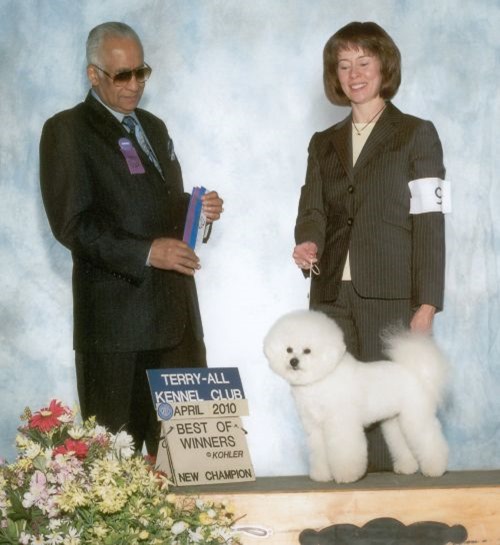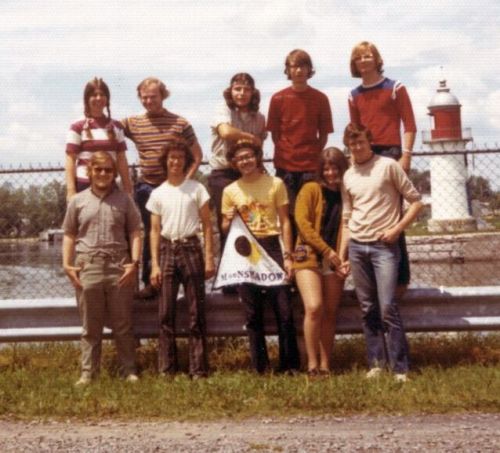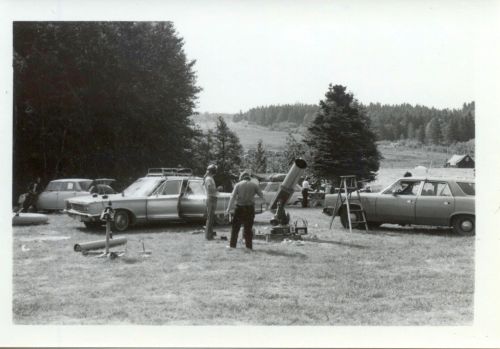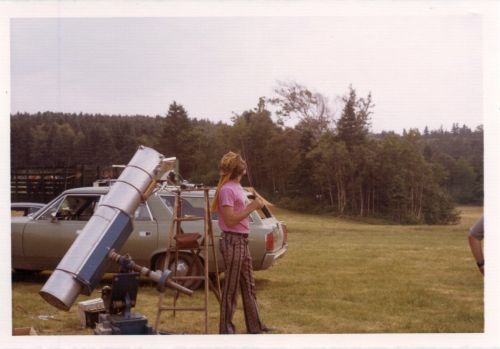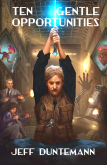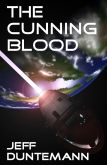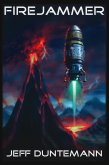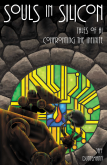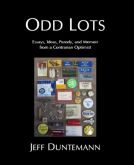…on YouTube. I’ve been poking around on YouTube in my odd moments, looking for tutorials, music videos, cartoons, and anything else that popped into my head that might be sound and/or video. The other day, I went looking for monsters. And not just any monsters. What I searched for were the monsters I saw on TV when I was quite young. Some of them scared the hell out of me when I was 8 or 9. Some of them were so cheesy that I laughed at them even then. The really scary thing about this YouTube adventure is that I found every last one of them. (Or at least their trailers.) On YouTube. Most were free to watch in their entirety–not that I did.
First on my list was The Creeping Unknown, (1955) which in the UK was called The Quatermass Experiment. This got a lot of play when I was in grade school, and my father, having seen it on the family-room TV a few too many times, dubbed it The Creeping Kilowatt Crud. You can see the whole thing on YouTube. I wasn’t expecting it to be remastered to film resolution, which makes it look way better than it did on any of our TVs. I didn’t watch all of it. I mostly ran the slider across until I found “the good parts;” i.e., where they actually show the monster or at least the cool Heinleinian spaceship it rode in on. I vividly recall my annoyance at seeing most monster movies having a lot of talking and running around and (occasionally) some kissing (yukkh!) but…not much monster. The Creeping Unknown was better than most in that regard, though the monster was a not-quite-a-blob creature who was originally an astronaut who brought back an alien infection from…somewhere…and gradually turned into the monster. It crawled around and was eventually electrocuited on a repair scaffold somewhere inside Westminster Abbey, hence my father’s nickname for it.
I remembered the monster badly; I thought it was a true blob monster, but hey–at late 1950s TV resolution, it might as well have been. If you like period pieces, watch the whole thing. For the monster genre, it was surprisingly well done.
Not all were. For a true blob monster (which were a sort of Hollywood cottage industry in that era) I had to dredge up X the Unknown (1956.) It was an obvious ripoff of The Creeping Unknown, done on the cheap. The monster was a big black tarry glob that bubbles up out of a hole in the Scottish highlands and starts eating people. The monster didn’t get much screen time, but I remember one very well-executed shot of the monster rolling toward a town. I recognized the technique immediately: They had mixed up something viscous but cohesive, colored it black, and photographed it rolling down a sloping miniature set, with the camera in the plane of the set. On screen, it was a house-sized blob monster rolling down a country road on its merry way. Well-done, and scary in spots, even if the seams were often visible.
Much scarier in a body-horror way is a blob movie called Caltiki, The Immortal Monster (1959.) (Italian titles; dubbed in English.) A sort of spaghetti monster movie, it came from Italy and scared the crap out of a lot of young Americans, myself included. A researcher in Mexico discovers that the Mayans didn’t just disappear; a blob monster ate them. And sunuvugun if the monster isn’t still there, and still hungry. The monster gets a reasonable amount of screen time, especially toward the end. And yes, it looks like a livingroom’s worth of bad ’70s carpeting dyed black with a couple of extras underneath it, pushing it around in bloblike ways. The scary parts are seeing what it does to the unfortunates it latches onto. Even when I was ten, I could tell the dialog did not match the lip movements of the actors. I didn’t care. Monsters are a language in and of themselves.
Sure, I watched it (back in the Sixties) but the less said about The Unknown Terror (1957) the better. I’ll give you a rank spoiler here and say that the monster looks a lot like…man-eating soapsuds.
Oddly, I never saw The Blob (1958) when I was a kid. Maybe the local TV stations thought it was too scary. Dunno. If it had been on Chicago’s Channel 7 (as most monster flicks were) well, I would have seen it. You can watch the whole thing (this time in color) at the link above. Lots of footage of the pinkish-purple Blob eating people, though as blobs go it was kind of featureless and, given the color they made it, did not carry much sense of menace.
So much for blobs. There are doubtless other blob movies that I haven’t heard of. (Got any?) Blobs, are, well, cheap, compared to dinosaurs or aliens. Now for a much better monster; indeed, one of my all-time favorites: 20 Million Miles to Earth (1957; the link is to a monster-rich excerpt) has a Ray Harryhausen animated monster. And, weirdly, the scriptwriter was the older sister of the nice lady who lived next door to where I grew up. Charlott Knight (1894-1977) used to come visiting from Hollywood circa 1960, and she would sit on the front porch of her sister’s house and tell stories to the neighborhood kids, including me. She told us she wrote 20 Million Miles to Earth, (which we had seen on TV more than once) and I admit I didn’t believe her at the time. It wasn’t until IMDB appeared that I could look her up, and…yes. That was her. She also played bit parts on Pettitcoat Junction. The monster in the movie (which Charlott called a “Ymir,” though the word is not used in the film itself) was the first I’d seen with a sympathetic edge. Astrononauts took an egg from Venus, brought it to Earth, and hatched the poor thing into a world its kind had never known. It grew quickly, though as best I recall the only thing it ate was sulfur. (The full movie, being a Harryhausen, is still being marketed and is not available on YouTube.) It gets loose in Rome, fights a hapless elephant, and is harrassed by the Italian military as it climbs around on the Colosseum, making a mess. By the end I felt sorry for it. Sympathetic monsters have since become a thing, but this is the oldest example I can think of. And I knew the person who thought it up, wow.
Now, I recall a childhood fear of robots. I dreamed once that a gigantic metal robot foot stomped on the Weinbergers’ house across the street. Where that came from is a bit of a mystery. Scary robots were less common than other monsters, and the ones I remember seeing weren’t all that scary. Gog (1954) starred two mini-tank robots built to ride a rocket into outer space. The robots were cool, though we don’t actually see them until half the film is over. In truth, they got very little screen time at all, and were not in fact the actual villains in the story. In Tobor the Great (1954) the robot was the good guy, as was Robbie in Forbidden Planet (1956).
For a real robot bad guy from my childhood, I have to cite Kronos (1957). The premise is stone-dumb: Aliens somewhere are running short on something, so they send a sort of gigantic robot battery to Earth to suck up all our electricity and take it home–so that the aliens can convert that energy into matter. (They must have run out of asteroids.) The robot itself, however, was unlike anything else in monster cinema: It consisted of two huge cubes connected by a neck, with a dome and a pair of antennae on top. It was several hundred feet tall. It had four cylindrical legs that went up and down, and some kind of rotating force cushion beneath it, or something. It lands on the Mexican coast, and marches north toward LA, stepping on Mexicans and sucking up energy from any powerplant it encounters. It even inhales the energy of a nuclear bomb, dropped on it by an actual B-36. Eventually they decide to short it out, and like any battery with a sufficiently low internal resistance would, it melts. Dumb as the premise was, Kronos the robot had considerable novelty value: It was not just some guy in a robot suit. The models and the opticals were pretty decent for 1957. It’s good enough to waste an hour and a half on the next time you catch a bad cold, though with a warning: There’s…kissing.
So, apart from Kronos, I’m not sure what gave me robotophobia as a five-year-old. Mutant dinosaurs like The Giant Behemoth (1959; nice 1080p rip) and Godzilla (1954) didn’t do much for me. Ditto Rodan (1956) and Gorgo (1961), though Rodan had his moments. Dinosaurs were already scary; making them even bigger did not make them any scarier. Mothra? (1962) A giant…moth? ummm…no. For real chills and grade-school nightmares, nothing in that era could compare to… The Crawling Eye (1958).
The film was made in England, and called The Trollenberg Terror over there. Mountain climbers in the Trollenberg (a German mountain range) start getting their heads torn off up at the summit. Cold-climate aliens are holed up in the crags somewhere, trying to get ahead. (Sorry.) When the supply of mountain climber heads thins out, they start edging down the mountain, looking for more.
I had literally not seen the film in fifty-odd years, and remembered the monsters badly. They were huge fat octopus-like things, with lots of squirmy tentacles and one great big bloodshot eye in the middle of it all. In 1965 or so, I thought the special effects people had cheaped out and painted a pupil on a beachball for the eye. It was better than that. You don’t have to take my word for it. And you don’t even have to watch the whole damned movie. Somebody with a serious monster fetish has copied out all the scenes that actually show the monster, and you can see it here. Got three and a half minutes to waste? That’s all it takes. Way back in the Sixties, we watched the whole thing for three minutes of monster. My research tells me that that’s not an aberration. That’s how the monster genre worked.
There were a lot of other monster flicks in that era. The ones I cite here are the ones I remember most vividly. The ones more easily forgotten had cheesy monsters or almost no monsters at all. Curse of the Demon was originally filmed without a visible monster. They put one in because everybody wanted to see the Demon. It was cheesy as…hell, heh. It was onscreen for maybe a minute and a half. I saw it once and that was plenty. I saw The She Creature, but it was a cheap ripoff of The Creature from the Black Lagoon and I confess I don’t recall anything but the fact that the monster was visibly female. The Monolith Monsters were gigantic crystals that grew and spread before the good guys do…something. (I forgot what.) My only clear impression is that the crystals would be relatively easy to outrun.
Oh, there were lots more. The Amazing Collosal Man (1957) and its way dumber sequel, War of the Collosal Beast (1958.) Reptilicus (1961) which I saw at an outdoor theater in Green Bay, with my cousins. The monster was a puppet; kind of like Cecil the Seasick Sea Serpent, with fangs. The Giant Claw (1957.) It looked like an enormous turkey buzzard. I already knew what turkey buzzards looked like. Making one huge only made it look silly.
And on and on and on. We have better monsters these days, including some really scary robots, like AMEE from Red Planet (2000). (AMEE may be the scariest robot in any movie, ever.) And, of course, Alien/Aliens (1979/86), Predator (1987), Cloverfield (2008) and numerous others. The big difference is that I wasn’t ten years old when I saw Alien. (I was 27.) As I wrote here some years ago, monster movies are how young boys learn bravery. It was certainly true for me. Now, I can look back at the whole silly-ass genre…and laugh.
That was a lot harder in 1962, trust me.

